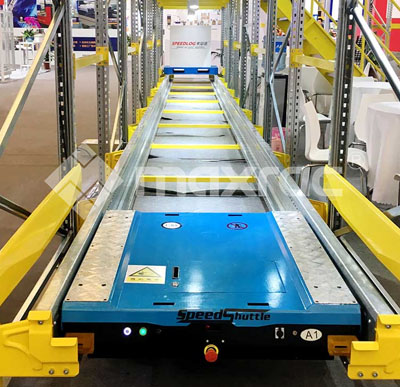The radio shuttle rack is an advanced storage solution designed to optimize warehouse space and improve the efficiency of pallet handling. This semi-automated system uses a radio-controlled shuttle to move pallets within racking, eliminating the need for forklifts to enter the storage aisles. The radio shuttle rack is ideal for high-density storage, enhancing both productivity and safety in warehouse operations.
The radio shuttle rack system comprises several key components, each playing a crucial role in its functionality.
Racking Structure: The racking structure is a robust framework designed to hold pallets. It consists of vertical uprights, horizontal beams, and rails on which the shuttle operates. The racking is customizable to fit various warehouse sizes and pallet configurations.
Radio Shuttle: The radio shuttle is a battery-powered, remote-controlled vehicle that moves pallets within the racking system. It can travel horizontally along the rails, lifting and transporting pallets to designated positions within the storage lanes.
Remote Control System: The shuttle is operated via a remote control, allowing operators to manage pallet movements efficiently. The system can be integrated with warehouse management software (WMS) for automated control and inventory tracking.
Battery Charging Station: The shuttle's batteries require regular charging to maintain operational efficiency. Charging stations are strategically placed within the warehouse for easy access and quick recharging.
The radio shuttle rack system operates through a straightforward yet effective process:
Forklifts place pallets at the entry point of the storage lanes. The radio shuttle, controlled remotely, then picks up the pallet and transports it along the rails to the desired position within the lane. This process is repeated for each pallet, maximizing storage density and minimizing the need for forklifts to enter the racking structure.

When retrieving pallets, the shuttle is directed to the specific lane and position where the pallet is stored. It lifts the pallet and transports it to the front of the lane, where a forklift can easily pick it up for further handling. This system ensures quick and efficient retrieval of pallets.
The radio shuttle rack system offers numerous benefits, making it a popular choice for modern warehouses and distribution centers.
The system allows for deep lane storage, significantly increasing storage capacity compared to traditional racking systems. By utilizing the full depth of the storage lanes, warehouses can store more pallets in the same amount of space.
The radio shuttle reduces the time and labor required for pallet handling. By automating the movement of pallets within the racking, the system streamlines operations and boosts overall productivity.
With forklifts no longer needing to enter the racking structure, the risk of accidents and damage to the racking and stored goods is minimized. This leads to a safer working environment for warehouse personnel.
The radio shuttle rack system is highly adaptable to different warehouse layouts and storage requirements. It can easily be scaled up or down based on changing inventory needs, making it a flexible solution for businesses of all sizes.
The versatility of radio shuttle rack systems makes them suitable for a wide range of industries and applications:
Food and Beverage: Ideal for storing perishable goods that require quick access and efficient rotation, such as FIFO (First In, First Out) inventory management.
Cold Storage: Efficiently utilizes space in temperature-controlled environments, reducing energy costs by optimizing storage density.
Automotive: Manages large volumes of parts and components, streamlining supply chain operations.
Retail: Supports high turnover inventory and seasonal stock, enhancing distribution efficiency.
Q: How does the radio shuttle receive its commands?
A: The radio shuttle is operated via a remote control or integrated with a warehouse management system (WMS) that sends automated commands for pallet movement.
Q: What is the battery life of a radio shuttle?
A: The battery life of a radio shuttle varies depending on the model and usage but typically lasts between 8 to 12 hours on a full charge. Charging stations are available for quick recharging.
Q: Can the radio shuttle rack system handle different pallet sizes?
A: Yes, the system is customizable and can be adjusted to accommodate various pallet sizes and weights, providing flexibility for different storage needs.
Q: What are the maintenance requirements for a radio shuttle rack system?
A: Regular maintenance includes inspecting the racking structure, ensuring the shuttle's batteries are charged, and performing routine checks on the shuttle's mechanical and electronic components. Proper maintenance ensures the system's longevity and reliability.
In conclusion, the radio shuttle rack system is a highly efficient and flexible solution for modern warehousing needs. By understanding its components, operation, and benefits, businesses can significantly enhance their storage capabilities, improve operational efficiency, and ensure a safer working environment.